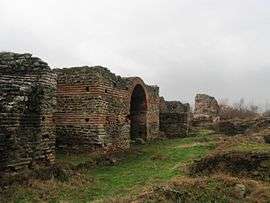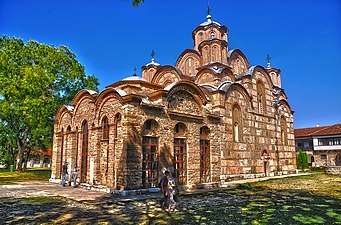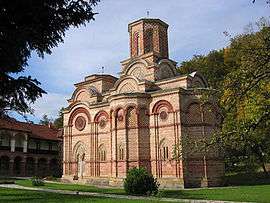Eastern Orthodoxy in Serbia
Eastern Orthodoxy is the main Christian denomination in Serbia, with 6,079,396 followers or 84.6% of the population, followed traditionally by the majority of Serbs, and also Romanians, Vlachs, Montenegrins, Macedonians and Bulgarians living in Serbia. The dominant Eastern Orthodox church in Serbia is the Serbian Orthodox Church. Also, the Romanian Orthodox Church has its own Diocese of Dacia Felix that operates among Orthodox Romanians in Serbian Banat and the Timok Valley.



-en.svg.png)

History
Late Antiquity and early Middle Ages
During Late Antiquity, on the territory of present-day Serbia there were several major Christian centers and episcopal sees, including Sirmium, Singidunum, Viminacium, Naissus, Ulpiana and others. In 535, Byzantine emperor Justinian I created new Archbishopric of Justiniana Prima, centered in the city of Justiniana Prima near present-day town of Lebane in central Serbia.
Middle Ages and early Modern Period
The identity of ethnic Serbs was historically based on Orthodox Christianity; the Serbian Orthodox Church, to the extent that some people claimed that those who were not Orthodox, were not Serbs. The Christianization of the Serbian lands took place in the 9th century, and Serbia (the Serbian Principality) is accounted Christian as of 870,[1] when the Eparchy of Ras and Braničevo were founded, confirmed by the Eighth Ecumenical Council (879-880).[2] The Serbian bishoprics became part of the Archbishopric of Ohrid, after the Byzantine conquest of the Bulgarian Empire in 1018. The Slavic language replaced the Greek in liturgical language.[3]
With the Great Schism in 1054 (the split between the Byzantine East and the Papal West), Serbia remained under Constantinople, while neighbouring Croatia remained under Rome. The Serbian Church was given autocephaly in 1219, when Archbishop Sava was recognized by the Ecumenical Patriarch of Constantinople. In 1346, it was raised to the rank of Patriarchate. During late Middle Ages and Early Modern period, Serbian Patriarchate of Peć (1346-1766) had at its peak more than forty eparchies.
Serbian Orthodox Church in Serbia
Fifteen eparchies (dioceses) of the Serbian Orthodox Church cover the territory of Serbia:
- Archbishopric of Belgrade and Karlovci, patriarchal eparchy
- Eparchy of Bačka, with seat in Novi Sad
- Eparchy of Banat, with seat in Vršac
- Eparchy of Braničevo, with seat in Požarevac
- Eparchy of Kruševac, with seat in Kruševac
- Eparchy of Mileševa, with seat in Prijepolje (partially covers southwestern region of Serbia and northwestern region of Montenegro)
- Eparchy of Niš, with seat in Niš
- Eparchy of Raška and Prizren, with seat in Prizren
- Eparchy of Šabac, with seat in Šabac
- Eparchy of Srem, with seat in Sremski Karlovci
- Eparchy of Šumadija, with seat in Kragujevac
- Eparchy of Timok, with seat in Zaječar
- Eparchy of Valjevo, with seat in Valjevo
- Eparchy of Vranje, with seat in Vranje
- Eparchy of Žiča, with seat in Kraljevo
See also
References
- Vlasto 1970, p. 208
- Vlasto 1970, p. 209
- Ćorović, Drugi Period, IV. Pokrštavanje Južnih Slovena
Sources
- Vlasto, A. P. (1970). The Entry of the Slavs into Christendom: An Introduction to the Medieval History of the Slavs. Cambridge: Cambridge University Press. ISBN 9780521074599.CS1 maint: ref=harv (link)
- Ćorović, Vladimir (1941). "Iсторија српског народа (Istorija srpskog naroda)". Internet, 2001) (in Serbian). Пројекат Растко: Библиотека српске културе; Projekat Rastko: Biblioteka srpske kulture.
- Ćirković, Sima (2004). The Serbs. Malden: Blackwell Publishing.CS1 maint: ref=harv (link)
